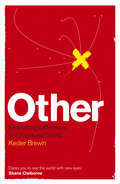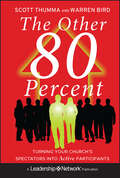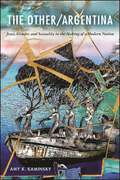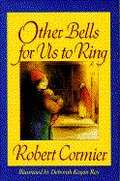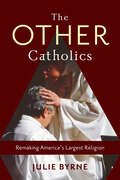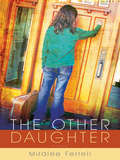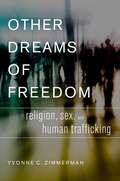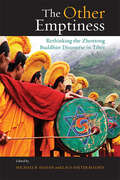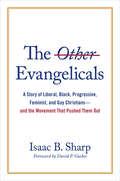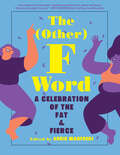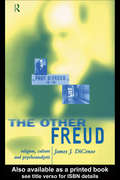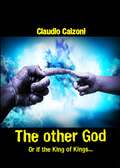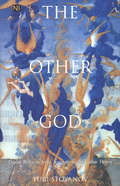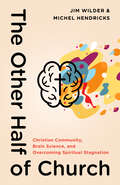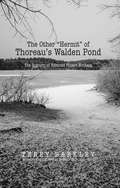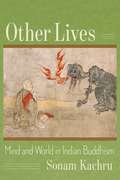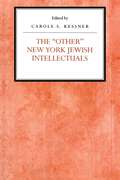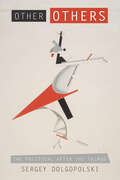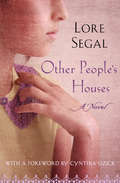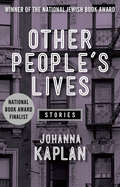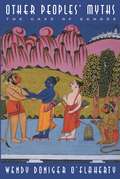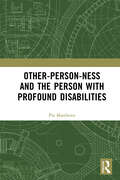- Table View
- List View
Other: Embracing Difference in a Fractured World
by Kester BrewinTeacher, which is the greatest commandment in the Law?'Jesus replied: '"Love the Lord your God with all your heart and with all your soul and with all your mind." This is the first and greatest commandment. And the second is like it: "Love your neighbour as yourself." All the Law and the Prophets hang on these two commandments.' Matthew 22:36-40Noisy neighbours, international terrorism, racism, teenage violence and religious fundamentalism ...from the personal to the local to the international and theological, it is our failure to engage 'the other' that is at the heart of so many of the problems we face. Beginning with Jesus' instruction to love God, and love our neighbour as we love ourselves, Brewin explores how we might better engage 'the other' within the Self, within God and within the worlds we inhabit.Drawing on Brewin's work as a theologian, poet and teacher this accessible and highly original work prompts us to reconsider the key question of 'what kind of selves do we need to be in order to live in harmony with others?
The Other 80 Percent
by Warren Bird Scott ThummaA research-based approach to developing more active and involved congregationsIn this practical resource, well-known and respected researcher Scott Thumma and professional co-writer Warren Bird draw upon new and heretofore unpublished research across a broad range of Protestant churches of all sizes and show how to create more active members. Offers solid information of what church leaders need to know about the factors and practices that create church members who are more actively and passionately involved in their congregations.Offers a first of its kind resource for developing engaged congregations Lead author Scott Thumma is a noted researcher and writer on congregational studiesWarren Bird is coauthor of Culture Shift and Viral ChurchesThis book offers advice for moving church members from being spectators to living a life of discipleship and faith.
The Other/Argentina: Jews, Gender, and Sexuality in the Making of a Modern Nation (SUNY Press Open Access)
by Amy K. KaminskyThe Other/Argentina looks at literature, film, and the visual arts to examine the threads of Jewishness that create patterns of meaning within the fabric of Argentine self-representation. A multiethnic yet deeply Roman Catholic country, Argentina has worked mightily to fashion itself as a modern nation. In so doing, it has grappled with the paradox of Jewishness, emblematic both of modernity and of the lingering traces of the premodern. By the same token, Jewishness is woven into, but also other to, Argentineity. Consequently, books, movies, and art that reflect on Jewishness play a significant role in shaping Argentina's cultural landscape. In the process they necessarily inscribe, and sometimes confound, norms of gender and sexuality.Just as Jewishness seeps into Argentina, Argentina's history, politics, and culture mark Jewishness and alter its meaning. The feminized body of the Jewish male, for example, is deeply rooted in Western tradition; but the stigmatized body of the Jewish prostitute and the lacerated body of the Jewish torture victim acquire particular significance in Argentina. Furthermore, Argentina's iconic Jewish figures include not only the peddler and the scholar, but also the Jewish gaucho and the urban mobster, troubling conventional readings of Jewish masculinity.As it searches for threads of Jewishness, richly imbued with the complexities of gender and sexuality, The Other/Argentina explores the patterns those threads weave, however overtly or subtly, into the fabric of Argentine national meaning, especially at such critical moments in Argentine history as the period of massive state-sponsored immigration, the rise of labor and anarchist movements, the Perón era, and the 1976–83 dictatorship. In arguing that Jewishness is an essential element of Argentina's self-fashioning as a modern nation, the book shifts the focus in Latin American Jewish studies from Jewish identity to the meaning of Jewishness for the nation.This book is freely available in an open access edition thanks to the National Endowment for the Humanities Fellowships Open Book Program—a limited competition designed to make outstanding humanities books available to a wide audience. Learn more at the Fellowships Open Book Program website at: https://www.neh.gov/grants/odh/FOBP, and access the book online at the SUNY Open Access Repository at http://hdl.handle.net/20.500.12648/1711.
Other Bells for Us to Ring
by Robert Cormier[From the front flap:] "At eleven, Darcy has never had a best friend, but this summer she's met the unsinkable Kathleen Mary O'Hara, who, like Darcy, is an outsider in Frenchtown. Darcy has never lived for long in any one place, but it's wartime and her father is in the army somewhere in Europe. Because her own family is Unitarian, Darcy is spellbound by Kathleen Mary's vivid tales about Catholicism. But after that careless baptism, she's stunned. A bit of holy water can't make you a Catholic, or can it? Was Kathleen Mary joking? Must she now go to church every Sunday? Can she eat meat on Friday? Then Kathleen Marry and her family disappear from Frenchtown, and Darcy waits in vain for word from her friend who promised she'd never leave her. Soon after, Darcy learns that her father is missing in action. Desperate and forlorn, Darcy seeks out an old nun known for her spiritual wisdom. Religion is about love, the nun tells her, and about miracles. It's Christmas now, but Darcy remains unsure about the power of God's love until she gets a message from Kathleen Mary--in the form of a miracle. Robert Cormier's first book for children is a touching and profound portrayal of Darcy's curiosity--and doubt--about faith that will appeal to all those who struggle to make sense of a bewildering world." Readers will sympathize with the feelings of eleven-year-olds and learn about life and situations of families whose loved ones served in the armed forces during World War II. Practices of Catholicism and Unitarianism are seen simply through the eyes of children and the point made that there are many ways to God which, no matter what the religion, involve faith and love.
The Other Catholics: Remaking America's Largest Religion
by Julie ByrneIndependent Catholics are not formally connected to the pope in Rome. They practice apostolic succession, seven sacraments, and devotion to the saints. But without a pope, they can change quickly and experiment freely, with some affirming communion for the divorced, women's ordination, clerical marriage, and same-sex marriage. From their early modern origins in the Netherlands to their contemporary proliferation in the United States, these "other Catholics" represent an unusually liberal, mobile, and creative version of America's largest religion.In The Other Catholics, Julie Byrne shares the remarkable history and current activity of independent Catholics, who number at least two hundred communities and a million members across the United States. She focuses in particular on the Church of Antioch, one of the first Catholic groups to ordain women in modern times. Through archival documents and interviews, Byrne tells the story of the unforgettable leaders and surprising influence of these understudied churches, which, when included in Catholic history, change the narrative arc and total shape of modern Catholicism. As Pope Francis fights to soften Roman doctrines with a pastoral touch and his fellow Roman bishops push back with equal passion, independent Catholics continue to leap ahead of Roman reform, keeping key Catholic traditions but adding a progressive difference.
The Other Catholics: Remaking America's Largest Religion
by Julie Byrne&“An excellent study of churches on the fringe that incubate new ideas and shed new light on mainstream religion.&”—Times Higher Education Independent Catholics are not formally connected to the pope in Rome. They practice apostolic succession, seven sacraments, and devotion to the saints. But without a pope, they can change quickly and experiment freely—with some affirming communion for the divorced, women&’s ordination, clerical marriage, and same-sex marriage. From their early modern origins in the Netherlands to their contemporary proliferation in the United States, these &“other Catholics&” represent an unusually liberal, mobile, and creative version of America&’s largest religion. In The Other Catholics, Julie Byrne shares the remarkable history and current activity of independent Catholics, who number at least two hundred communities and a million members across the United States. She focuses in particular on the Church of Antioch, one of the first Catholic groups to ordain women in modern times. Through archival documents and interviews, Byrne tells the story of the unforgettable leaders and surprising influence of these understudied churches, which, when included in Catholic history, change the narrative arc and total shape of modern Catholicism. As Pope Francis fights to soften Roman doctrines with a pastoral touch and his fellow Roman bishops push back with equal passion, independent Catholics continue to leap ahead of Roman reform, keeping key Catholic traditions but adding a progressive difference. &“Byrne&’s enlightening research and analysis will undoubtedly raise awareness of these little-known Catholic denominations.&”
The Other Daughter: A Novel
by Miralee FerrellSusanne Carson's well-ordered family life is thrown into devastating chaos when Brianna, a young teen, appears on her doorstep, claiming to be the daughter of Susanne's husband, David. The revelation of David's apparent betrayal adds strain to an already fragile marriage. Will this shocking discovery drive the family apart, or will it draw them closer to God? Guaranteed fiction!
Other Dreams of Freedom: Religion, Sex and Human Trafficking
by Yvonne C. ZimmermanYvonne C. Zimmerman offers a groundbreaking exploration of the relationship between freedom and sexual regulation in American anti-human trafficking law and policies. . She argues that the religious values of American Protestantism have indelibly shaped the federal government's approach to engaging human trafficking, and that the trajectory of the U.S.'s anti-trafficking efforts cannot be fully grasped without understanding the unique ways in which sex, morality, and freedom are connected in Protestant Christian configurations of morality.
The Other Emptiness: Rethinking the Zhentong Buddhist Discourse in Tibet
by Michael R. Sheehy; Klaus-Dieter MathesThis book brings together perspectives of leading international Tibetan studies scholars on the subject of zhentong or "other-emptiness." Defined as the emptiness of everything other than the continuous luminous awareness that is one's own enlightened nature, this distinctive philosophical and contemplative presentation of emptiness is quite different from rangtong—emptiness that lacks independent existence, which has had a strong influence on the dissemination of Buddhist philosophy in the West. Important topics are addressed, including the history, literature, and philosophy of emptiness that have contributed to zhentong thinking in Tibet from the thirteenth century until today. The contributors examine a wide range of views on zhentong from each of the major orders of Tibetan Buddhism, highlighting the key Tibetan thinkers in the zhentong philosophical tradition. Also discussed are the early formulations of buddhanature, interpretations of cosmic time, polemical debates about emptiness in Tibet, the zhentong view of contemplation, and creative innovations of thought in Tibetan Buddhism. Highly accessible and informative, this book can be used as a scholarly resource as well as a textbook for teaching graduate and undergraduate courses on Buddhist philosophy.
The Other Evangelicals: A Story of Liberal, Black, Progressive, Feminist, and Gay Christians—and the Movement That Pushed Them Out
by Isaac B. SharpWhat&’s the first thing that comes to mind when you hear &“evangelical&”?For many, the answer is &“white,&” &“patriarchal,&” &“conservative,&” or &“fundamentalist&”—but as Isaac B. Sharp reveals, the &“big tent&” of evangelicalism has historically been much bigger than we&’ve been led to believe. In The Other Evangelicals, Sharp brings to light the stories of those twentieth-century evangelicals who didn&’t fit the mold, including Black, feminist, progressive, and gay Christians.Though the binary of fundamentalist evangelicals and modernist mainline Protestants is taken for granted today, Sharp demonstrates that fundamentalists and modernists battled over the title of &“evangelical&” in post–World War II America. In fact, many ideologies characteristic of evangelicalism today, such as &“biblical womanhood&” and political conservatism, arose only in reaction to the popularity of evangelical feminism and progressivism. Eventually, history was written by the &“winners&”—the Billy Grahams of American religion—while the &“losers&” were expelled from the movement via the establishment of institutions such as the National Association of Evangelicals.Carefully researched and deftly written, The Other Evangelicals offers a breath of fresh air for scholars seeking a more inclusive history of religion in America.
The (Other) F Word: A Celebration of the Fat & Fierce
by Angie Manfredi“This outstanding anthology of essays, illustrations, poems, and letters . . . is a celebration of every body and presents a revolutionary message” (Publishers Weekly, starred review). The time has come for fat people to tell their own stories. The (Other) F Word combines the voices of Renée Watson, Julie Murphy, Jes Baker, Samantha Irby, Bruce Sturgell, and many others in a relatable, revelatory and inspiring exploration of body image and fat acceptance. This dazzling collection of art, poetry, essays, and fashion tips is meant for people of all sizes who desire to be seen and heard in a culture consumed by a narrow definition of beauty. By combining the talents of renowned fat YA and middle-grade authors, as well as fat influencers and creators, The (Other) F Word offers teen readers and activists of all ages a tool for navigating our world with confidence and courage.
The Other Freud: Religion, Culture and Psychoanalysis
by James DiCensoFirst published in 1998. Routledge is an imprint of Taylor & Francis, an informa company.
The Other God: Or If The King Of Kings...
by Claudio CalzoniThe Other God Or If The King Of Kings... by Claudio Calzoni What would have happened if the life of the God who changed the history of man had been different? Claudio Calzoni elaborates an alternative future, a sliding door, for the Divine Being that is the basis of every modern society. The Other God Or If The King Of Kings... What would have happened if the life of the God who changed the history of man had been different? Claudio Calzoni elaborates an alternative future, a sliding door, for the Divine Being that is the basis of every modern society.
The Other God
by Mr Yuri StoyanovThis fascinating book explores the evolution of religious dualism, the doctrine that man and cosmos are constant battlegrounds between forces of good and evil. It traces this evolution from late Egyptian religion and the revelations of Zoroaster and the Orphics in antiquity through the Dead Sea Scrolls, the Mithraic Mysteries, and the great Gnostic teachers to its revival in medieval Europe with the suppression of the Bogomils and the Cathars, heirs to the age-long teachings of dualism. Integrating political, cultural, and religious history, Yuri Stoyanov illuminates the dualist religious systems, recreating in vivid detail the diverse worlds of their striking ideas and beliefs, their convoluted mythologies and symbolism. Reviews of an earlier edition:"A book of prime importance for anyone interested in the history of religious dualism. The author's knowledge of relevant original sources is remarkable; and he has distilled them into a convincing and very readable whole."--Sir Steven Runciman"The most fascinating historical detective story since Steven Runciman's Sicilian Vespers."--Colin Wilson"A splendid account of the decline of the dualist tradition in the East . . . both strong and accessible. . . . The most readable account of Balkan heresy ever."--Jeffrey B. Russell, Journal of Religion "Well-written, fact-filled, and fascinating . . . has in it the making of a classic."--Harry T. Norris, Bulletin of SOAS
The Other Half of Church: Christian Community, Brain Science, and Overcoming Spiritual Stagnation
by Jim Wilder Michel HendricksCould brain science be the key to spiritual formation?Why does true Christian transformation seem fleeting? And why does church often feel lonely, Christian community shallow, and leaders untrustworthy? For many Christians, the delight of encountering Christ eventually dwindles—and disappointment sets in. Is lasting joy possible?These are some of the questions Michel Hendricks has considered both in his experience as a spiritual formation pastor and in his lifetime as a Christian. He began to find answers when he met Jim Wilder—a neurotheologian. Using brain science, Wilder identified that there are two halves of the church: the rational half and the relational half. And when Christians only embrace the rational half, churches become unhealthy places where transformation doesn&’t last and narcissistic leaders flourish.In The Other Half of Church, join Michel and Jim's journey as they couple brain science with the Bible to identify how to overcome spiritual stagnation by living a full-brained faith. You'll also learn the four ingredients necessary to develop and maintain a vibrant transformational community where spiritual formation occurs, relationships flourish, and the toxic spread of narcissism is eradicated.
The Other Half of Church: Christian Community, Brain Science, and Overcoming Spiritual Stagnation
by Jim Wilder Michel HendricksCould brain science be the key to spiritual formation?Why does true Christian transformation seem fleeting? And why does church often feel lonely, Christian community shallow, and leaders untrustworthy? For many Christians, the delight of encountering Christ eventually dwindles—and disappointment sets in. Is lasting joy possible?These are some of the questions Michel Hendricks has considered both in his experience as a spiritual formation pastor and in his lifetime as a Christian. He began to find answers when he met Jim Wilder—a neurotheologian. Using brain science, Wilder identified that there are two halves of the church: the rational half and the relational half. And when Christians only embrace the rational half, churches become unhealthy places where transformation doesn&’t last and narcissistic leaders flourish.In The Other Half of Church, join Michel and Jim's journey as they couple brain science with the Bible to identify how to overcome spiritual stagnation by living a full-brained faith. You'll also learn the four ingredients necessary to develop and maintain a vibrant transformational community where spiritual formation occurs, relationships flourish, and the toxic spread of narcissism is eradicated.
The Other “Hermit” of Thoreau’s Walden Pond: The Sojourn of Edmond Stuart Hotham
by Terry Barkley“I didn’t realize there was another ‘hermit’ of Walden Pond!” is the usual response author-historian Terry Barkley receives when he tells someone the subject of his new book. Henry David Thoreau’s experiment there from 1845-1847 is widely known and immortalized in his classic Walden; or, Life in the Woods (1854). However, stresses Barkley, “Neither the world nor even most avid Thoreauvians know about Edmond Hotham’s six-months at Walden Pond during the winter of 1868-1869,” the fascinating story of which is detailed in The Other “Hermit” of Thoreau’s Walden Pond: The Sojourn of Edmond Stuart Hotham. A generation later and nearly seven years after Henry Thoreau died in 1862 of tuberculosis in Concord, Massachusetts, a young theological student from New York City arrived in Concord in November 1868. Edmond Hotham had never been there, but he immediately began preparations to pursue the “wild life.” He met transcendentalist poet (William) Ellery Channing, a former close friend of Thoreau’s who had suggested to Thoreau that he build his cabin at Walden Pond. It was Channing who likely introduced Hotham to transcendentalist leader Ralph Waldo Emerson (the “Sage of Concord”), and Emerson who gave Hotham permission, like Thoreau before him, to build his “Earth-cabin” on the poet’s property at Walden Pond. Edmond Hotham’s sojourn at Walden Pond was the first and only time someone traveled to Walden Pond to emulate Thoreau’s experiment in simplicity. Hotham made his way to Walden Pond to pursue some “private business” while he was preparing for Christian ministry and stateside missionary work. He built his shanty on the pond’s shore about 100 yards in front of Thoreau’s, where he attempted to out-economize and out-simplify Thoreau. Hotham’s sojourn as the second “hermit” at Walden Pond exemplified the growing adulation of Henry David Thoreau and his literary work. Author Terry Barkley has gleaned archival sources, vital records, period newspaper accounts, and census rolls for everything that is known about Edmond Hotham. The Other “Hermit” of Thoreau’s Walden Pond is the first book-length treatise on Hotham, half of which is wholly new material. It far supersedes the late Kenneth Walter Cameron’s 1962 article on Hotham, which until now was the most complete study of the man. Barkley’s groundbreaking study book is an important addition to the Concord-Walden Pond story and a fascinating read. To quote Thoreau, “What is once well done is done forever.”
Other Lives: Mind and World in Indian Buddhism
by Sonam KachruHuman experience is not confined to waking life. Do experiences in dreams matter? Humans are not the only living beings who have experiences. Does nonhuman experience matter? The Buddhist philosopher Vasubandhu, writing during the late fourth and early fifth centuries C.E., argues in his work The Twenty Verses that these alternative contexts ought to inform our understanding of mind and world. Vasubandhu invites readers to explore experiences in dreams and to inhabit the experiences of nonhuman beings—animals, hungry ghosts, and beings in hell.Other Lives offers a deep engagement with Vasubandhu’s account of mind in a global philosophical perspective. Sonam Kachru takes up Vasubandhu’s challenge to think with perspective-diversifying contexts, showing how his novel theory draws together action and perception, minds and worlds. Kachru pieces together the conceptual system in which Vasubandhu thought to show the deep originality of the argument. He reconstructs Vasubandhu’s ecological concept of mind, in which mindedness is meaningful only in a nexus with life and world, to explore its ongoing philosophical significance. Engaging with a vast range of classical, modern, and contemporary Asian and Western thought, Other Lives is both a groundbreaking work in Buddhist studies and a model of truly global philosophy. The book also includes an accessible new translation of The Twenty Verses, providing a fresh introduction to one of the most influential works of Buddhist thought.
The Other New York Jewish Intellectuals (Reappraisals Jewish Social History)
by Carole S KessnerIrving Howe. Saul Bellow. Lionel Trilling. These are names that immediately come to mind when one thinks of the New York Jewish intellectuals of the late thirties and forties. And yet the New York Jewish intellectual community was far larger and more diverse than is commonly thought. In The Other New York Jewish Intellectuals we find a group of thinkers who may not have had widespread celebrity status but who fostered a real sense of community within the Jewish world in these troubled times. What unified these men and women was their commitment and allegiance to the Jewish people. Here we find Hayim Greenberg, Henry Hurwitz, Marie Syrkin, Maurice Samuel, Ben Halperin, Trude Weiss-Rosmarin, Morris Raphael Cohen, Ludwig Lewisohn, Milton Steinberg, Will Herberg, A. M. Klein, and Mordecai Kaplan, and many others. Divided into 3 sections--Opinion Makers, Men of Letters, and Spiritual Leaders--the book will be of particular interest to students and others interested in Jewish studies, American intellectual history, as well as history of the 30s and 40s.
Other Others: The Political after the Talmud
by Sergey DolgopolskiDenying recognition or even existence to certain others, while still tolerating diversity, stabilizes a political order; or does it? Revisiting this classical question of political theory, the book turns to the Talmud. That late ancient body of text and thought displays a new concept of the political, and thus a new take on the question of excluded others. Philosophy- and theology-driven approaches to the concept of the political have tacitly elided a concept of the political which the Talmud displays; yet, that elision becomes noticeable only by a methodical rereading of the pages of the Talmud through and despite the lens of contemporary competing theological and philosophical theories of the political. The book commits such rereading of the Talmud, which at the same time is a reconsideration of contemporary political theory. In that way, The Political intervenes both to the study of the Talmud and Jewish Thought in its aftermath, and to political theory in general.The question of the political for the excluded others, or for those who programmatically do not claim any “original” belonging to a particular territory comes at the forefront of analysis in the book. Other Others approaches this question by moving from a modern political figure of “Jew” as such an “other other” to the late ancient texts of the Talmud. The pages of the Talmud emerge in the book as a (dis)appearing display of the interpersonal rather than intersubjective political. The argument in the book arrives, at the end, to a demand to think earth anew, now beyond the notions of territory, land, nationalism or internationalism, or even beyond the notion of universe, that have defined the thinking of earth so far.
Other People's Houses: A Novel
by Lore SegalWith a foreword by Cynthia Ozick, this semiautobiographical novel of a Jewish girl forced away from home in the face of Nazi persecution is an extraordinary tale of fortitude and survivalOn a December night in 1938, a ten-year-old girl named Lore is put on the Kindertransport, a train carrying hundreds of Jewish children out of Austria to safety from Hitler&’s increasingly alarming oppression. Temporarily housed at the Dover Court Camp on England&’s east coast, Lore will find herself living in other people&’s houses for the next seven years: the Orthodox Levines, the Hoopers, the working-class Grimsleys, and the wealthy Miss Douglas and Mrs. Dillon.Charged with the task of asking &“the English people&” to get her parents out of Austria, Lore discovers in herself an impassioned writer. In letters to potential sponsors, she details the horrors happening back at home; in those to her parents, she notes the mannerisms and reactions of the new families around her as she valiantly tries to master their language. And the closer the world comes to a new war, the more resolute Lore becomes to survive.As powerful now as when it was first released fifty years ago, Other People&’s Houses is a poignant tale about the creation of a new life in the face of hopelessness and fear—a hallmark of the postwar immigration experience.
Other People's Lives: Stories
by Johanna KaplanFinalist for the National Book Award and winner of the Jewish Book Award: A collection of five stories and one novella from Johanna Kaplan exploring the private worlds of Jewish families in New York in the middle of the twentieth century In her first published literary work, Johanna Kaplan, acclaimed author of O My America!, examines the lives of other people with heart, humor, and a unique understanding of their problems, demons, and dreams. An achingly poignant collection of character-rich stories, Other People's Lives centers on the children and grandchildren of immigrants, mostly Jewish, living in urban America. They are people struggling with the past, mental illness, loss, family legacies, and all variety of expectation in the mid-twentieth century; they are transplanted strangers entering, and often imposing upon, the personal lives of others.From the brilliant title novella, in which a troubled young woman enters the rarefied orbit of a famous couple, to the delightfully appealing tale of a skeptical city girl's unhappy expulsion to a summer camp in the country, Kaplan's stories explore the power of self-delusion and the all-too-frequently unspoken pain of memory.
Other-person-ness and the Person with Profound Disabilities
by Pia MatthewsMany people think that profound disability presents us with a real problem, often because it seems difficult to connect with someone who does not seem to think or act like us. Positioning profound disability in this way immediately sets up a ‘them’ and ‘us’, where the person with profound disability becomes the problematic ‘other’. Attempts to bridge the ‘them’ and ‘us’ risk reducing everyone to the same where disability is not taken seriously.In contrast to a ‘them’ and ‘us’, and negative connotations of the other found in the existentialist philosophies of writers like Sartre and Beauvoir, Pia Matthews argues for a return to a positive view of the other. One positive approach to the other, based on an ethics of relationship as championed by Levinas, seems to mitigate the other-ness of profound disability. However, this still makes the person with profound disability dependent on the ethical concern of the more powerful other. Instead, this book argues for return to a personalist philosophy of being offered by Mounier, Marcel, and Wojtyła, and deepened by participation, belonging, and the possibility of contributing to the good of all. This deepened philosophy of being gives a more solid foundation for people who are especially at the mercy of others. It will be of interest to all scholars and students of disability studies, philosophy and anthropology.
